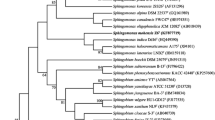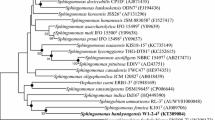Abstract
Two novel aerobic, gram-negative, rod-shaped bacterial strains designated strains REN5T and REN5-1, were isolated from pit mud of Baijiu in Sichuan province, China. Based on the 16S rRNA gene sequence similarity, both strains belonged to the genus Sphingomonas. Strains REN5T and REN5-1 showed the highest similarity with S. aquatilis (97.9–98.0%). The DNA G+C content of REN5T and REN5-1 were 67.62 and 67.57 mol %, respectively. The DNA-DNA relatedness values between strains REN5T and S. aquatilis, REN5-1 and S. aquatilis were 22.8 and 22.6%, respectively. The main isoprenoid quinone of REN5T was Q-10, the major fatty acids were C18:1ω7c, C16:0 and C14:0 2-OH, and the main are polar lipids were DPG (diphosphatidylglycerol), SGL (sphingoglycolipid), PG (phosphatidylglycerol), PC (phosphatidylcholine), PE (phosphatidylethanolamine), UPL (unidentified phospholipid) and UL (unidentified polar lipid). The polyphasic taxonomic data showed that strains REN5T and REN5-1 represented a novel species within the genus Sphingomonas, for which the name Sphingomonas beigongshangi sp. nov. is proposed, with the type strain REN5T (=GDMCC1.2211T = JCM 34404T).



Similar content being viewed by others
REFERENCES
Auch, A.F., Klenk, H., and Goeker, M., Standard operating procedure for calculating genome-to-genome distances based on high-scoring segment pairs, Stand. Genomic Sci., 2010, vol. 2, pp. 142−148.
Buonaurio, R., Stravato, V.M., Kosako, Y., Fujiwara, N., Naka, T., Kobayashi, K., Cappelli, C., and Yabuuchi, E., Sphingomonas melonis sp. nov., a novel pathogen that causes brown spots on yellow Spanish melon fruits, Int. J. Syst. Evol. Microbiol. 2002, vol. 52, pp. 2081−2087.
Busse, H.J., Denner, E., Buczolits, S., Salkinoja-Salonen, M., Bennasar, A., and Kampfer, P., Sphingomonas aurantiaca sp. nov., Sphingomonas aerolata sp. nov. and Sphingomonas faeni sp. nov., air- and dustborne and Antarctic, orange-pigmented, psychrotolerant bacteria, and emended description of the genus Sphingomonas, Int. J. Syst. Evol. Microbiol. 2003, vol. 53, pp. 1253−1260.
Busse, H.J., Hauser, E., and Kämpfer, P. Description of two novel species, Sphingomonas abaci sp. nov. and Sphingomonas panni sp. nov., Int. J. Syst. Evol. Microbiol., 2005, vol. 55, pt 6, pp. 2565−2569.
Chen, H., Jogler, M., Rohde, M., Klenk, H.P., Busse, H.J., Tindall, B.J., Sproer, C., and Overmann, J., Reclassification and emended description of Caulobacter leidyi as Sphingomonas leidyi comb. nov., and emendation of the genus Sphingomonas, Int. J. Syst. Evol. Microbiol., 2012, vol. 62, pp. 2835−2843.
Feng, G.D., Xiong, X., Zhu, H.H., and Li, H.P., Sphingomonas difficilis sp. nov., a difficultly cultivable bacterium that grows on solid but not in liquid medium, isolated from an abandoned lead-zinc mine, Int. J. Syst. Evol. Microbiol., 2017, vol. 7, pp. 5273−5278.
Feng, G.D., Yang, S.Z., Xiong, X., Li, H.P., and Zhu, H.H., Sphingomonas spermidinifaciens sp. nov., a novel bacterium containing spermidine as the major polyamine, isolated from an abandoned lead-zinc mine and emended descriptions of the genus Sphingomonas and the species Sphingomonas yantingensis and Sphingomonas japonica, Int. J. Syst. Evol. Microbiol., 2017, vol. 67, pp. 2160−2165.
Goodfellow, M., Collins, M.D., and Minnikin, D.E., Fatty acid and polar lipid composition in the classification of Kurthia, J. Appl. Bacteriol., 1980, vol. 48, pp. 269−276.
Hu, H.Y., Lim, B.R., Goto, N., and Fujie, K., Analytical precision and repeatability of respiratory quinones for quantitative study of microbial community structure in environmental samples, J. Microbiol. Methods, 2001, vol. 47, pp. 17−24.
Kanehisa, M. and Goto, S., KEGG: kyoto encyclopedia of genes and genomes, Nucleic Acids Res., 2000, vol. 28, pp. 27−30.
Kimura, M., A simple method for estimating evolutionary rates of base substitutions through comparative studies of nucleotide sequences, J. Mol. Evol., 1980, vol. 16, pp. 111−120.
Lee, J.S., Shin, Y.K., Yoon, J.H., Takeuchi, M., Pyun, Y.R., and Park, Y.H., Sphingomonas aquatilis sp. nov., Sphingomonas koreensis sp. nov., and Sphingomonas taejonensis sp. nov., yellow-pigmented bacteria isolated from natural mineral water, Int. J. Syst. Evol. Microbiol., 2001, vol. 51, no. 4, pp. 1491−1498.
Li, R., Li, Y., Kristiansen, K., and Wang, J., SOAP: short oligonucleotide alignment program, Bioinformatics, 2008, vol. 24, pp. 713−714.
Li, R., Zhu, H., Ruan, J., Qian, W., Fang, X., Shi, Z., Li, Y., Li, S., Shan, G., Kristiansen, K., Li, S., Yang, H., Wang, J., and Wang, J., De novo assembly of human genomes with massively parallel short read sequencing, Genome Res., 2010, vol. 20, pp. 265−272.
Liu, H.L. and Sun, B.G., Effect of fermentation processing on the flavor of Baijiu, J. Agric. Food Chem., 2018, vol. 66, pp. 5425−5432.
Liu, Q., Liu, H.C., Zhang, J.L., Zhou, Y.G., and Xin, Y.H., Sphingomonas psychrolutea sp. nov., a psychrotolerant bacterium isolated from glacier ice, Int. J. Syst. Evol. Microbiol., 2015, vol. 65, pp. 2955−2959.
Lombard, V., Ramulu, H.G, Drula, E., Coutinho, P.M., and Henrissat, B., The carbohydrate-active enzymes database (CAZy) in 2013, Nucleic Acids Res., 2014, vol. 42(D1), pp. D490−D495.
Powers, E.M., Efficacy of the Ryu nonstaining KOH technique for rapidly determining gram reactions of food-borne and waterborne bacteria and yeasts, Appl. Environ. Microbiol., 1995, vol. 61, pp. 3756−3758.
Saitou, N. and Nei, M., The neighbor-joining method: a new method for reconstructing phylogenetic trees, Mol. B-iol. Evol., 1987, vol. 4, pp. 406−425.
Sasser, M., Identification of bacteria by gas chromatography of cellular fatty acids, MIDI Technical Note 101, MIDI Inc., Newark, DE, USA.,1990.
Son, H.M., Yang, J.E., Park, Y., Han, C.K., Kim, S.G., Kook, M., and Yi, T.H., Sphingomonas kyungheensis sp. nov., a bacterium with ginsenoside-converting activity iso-lated from soil of a ginseng field, Int. J. Syst. Evol. Microbiol., 2013, vol. 63, pt 10, pp. 3848−3853.
Stothard, P. and Wishart, D. S., Circular genome visualization and exploration using CGView, Oxford Univ. Press, 2005.
Sun, Z., Guo, L., Yan, Y., Zhang, X., Wang, J., Liu, B., Xu, J., and Ren, Q., Sporosarcina beigongshangi sp. nov., isolated from pit mud of Baijiu, Arch. Microbiol., 2022, vol. 204, p. 10.
Takeuchi, M., Kawai, F., Shimada, Y., and Yokota, A., Taxonomic study of polyethylene glycol-utilizing bacteria: emended description of the genus Sphingomonas and new descriptions of Sphingomonas macrogoltabidus sp. nov., Sphingomonas sanguis sp. nov. and Sphingomonas terrae sp. nov., Syst. Appl. Microbiol., 1993, vol. 16, pp. 227−238.
Tamura, K., Stecher, G., Peterson, D., Filipski, A., and Kumar, S., MEGA6: molecular evolutionary genetics analysis version 6.0, Mol. Biol. Evol., 2013, vol. 30, pp. 2725−2729.
Tanner, K., Mancuso, C. P., Pereto, J., Khalil, A. S., Vilanova, C., and Pascual, J., Sphingomonas solaris sp. nov., isolated from a solar panel in Boston, Massachusetts, Int. J. Syst. Evol. Microbiol., 2020, vol.70, pp. 1814−1821.
Xie, C.H. and Yokota, A., Sphingomonas azotifigens sp. nov., a nitrogen-fixing bacterium isolated from the roots of Oryza sativa, Int. J. Syst. Evol. Microbiol., 2006, vol. 56, pt 4, pp. 889−893.
Xue, H., Piao, C.G., Wang, X.Z., Lin, C.L., Guo, M.W., and Li, Y., Sphingomonas aeria sp. nov., isolated from air, Int. J. Syst. Evol. Microbiol., 2018, vol. 68, pp. 2866−2871.
Yabuuchi, E., Kosako, Y., Fujiwara, N., Naka, T., Matsunaga, I., Ogura, H., and Kobayashi, K., Emendation of the genus Sphingomonas Yabuuchi et al. 1990 and junior objective synonymy of the species of three genera, Sphingobium, Novosphingobium and Sphingopyxis, in conjunction with Blastomonas ursincola, Int. J. Syst. Evol. Microbiol., 2002, vol. 52, pp. 1485−1496.
Yabuuchi, E., Yano, I., Oyaizu, H., Hashimoto, Y., Ezaki, T., and Yamamoto, H., Proposals of Sphingomonas paucimobilis gen. nov. and comb. nov., Sphingomonas parapaucimobilis sp. nov., Sphingomonas yanoikuyae sp. nov., Sphingomonas adhaesiva sp. nov., Sphingomonas capsulata comb. nov., and two genospecies of the genus Sphingomonas, Microbiol. Immunol., 1990, vol. 34, pp. 99−119.
Yang, S.S., Li, X.G., Xiao, X., Zhuang, G.J., and Zhang, Y., Sphingomonas profundi sp. nov., isolated from deep-sea sediment of the Mariana Trench, Int. J. Syst. Evol. Microbiol., 2020, vol. 70, pp. 3809−3815.
Yoon, J.H., Park, S., Kang, S.J., Kim, W., and Oh, T.K., Sphingomonas hankookensis sp. nov., isolated from wastewater, Int. J. Syst. Evol. Microbiol., 2009, vol. 59, pt 11, pp. 2788−2793.
Yoon, S., Ha, S., Kwon, S., Lim, J., Kim, Y., Seo, H., and Chun, J., Introducing EzBioCloud: a taxonomically united database of 16S rRNA gene sequences and whole-genome assemblies, Int. J. Syst. Evol. Microbiol., 2017, vol. 67, pp. 1613−1617.
Zheng, J., Liang, R., Zhang, L.Q., Wu, C.D., Zhou, R.Q., and Liao, X.P., Characterization of microbial communities in strong aromatic liquor fermentation pit muds of different ages assessed by combined DGGE and PLFA analyses, Food Res. Int., 2013, vol. 54, pp. 660−666.
Zheng, Y., Hu, X., Jia, Z., Bodelier, P.L.E., Guo, Z., Zhang, Y., Li, F., and He, P., Co-occurrence patterns among prokaryotes across an age gradient in pit mud of Chinese strong-flavor liquor, Can. J. Microbiol., 2020, vol. 66, pp. 495−504.
ACKNOWLEDGMENTS
We are grateful to Zou Xiaohui, associate researcher at National Institute for Viral Disease Control and Prevention, China CDC, with preparing transmission electron microscope.
Funding
This work supported by The National Key Research and Development Program of China (2018YFC1603606), Earmarked Fund for Hebei Edible Fungi Innovation Team of Modern Agro-Industry Technology Research System (HBCT2018050205), Science and Technology general project of Beijing municipal commission (KM202110011002), and Open fund project in Key Laboratory of Microbial Resources Collection and Preservation, Ministry of Agriculture and Rural Affairs (KLMRCP2021-03).
Author information
Authors and Affiliations
Contributions
AUTHOR CONTRIBUTIONS
Zh. Sun and J. Xu contributed equally to this work.
Conceptualization, Q.R. and S.M.L.; Formal analysis, Z.B.S., X.X. and J.L.; Funding acquisition, Q.R. and S.M.L.; Methodology, Z.B.S., J.L.X., X.X., Y.Y. and S.Y.H.; Writing—original draft, Z.B.S. and J.L.X.; Writing—review and editing, Q.R.
Corresponding authors
Ethics declarations
The authors declare that there are no conflicts of interest. None of the authors performed experiments with animal or human participants.
Supplementary Information
Rights and permissions
About this article
Cite this article
Sun, Z., Xu, J., Xing, X. et al. Sphingomonas beigongshangi sp. nov., Isolated from Pit Mud of Baijiu. Microbiology 92, 146–152 (2023). https://doi.org/10.1134/S0026261721101458
Received:
Revised:
Accepted:
Published:
Issue Date:
DOI: https://doi.org/10.1134/S0026261721101458




